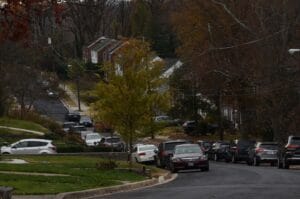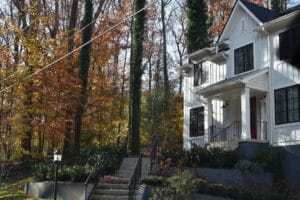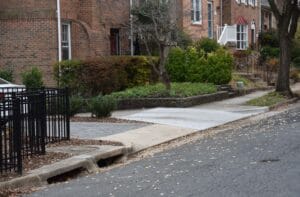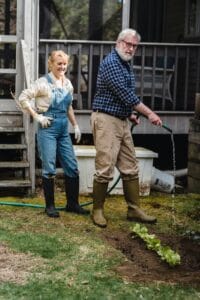If your property repeatedly flooded due to poor stormwater management and water coming from further uphill, what would you do to fix it? Would you try and control the flooding on your own lawn or go directly to the source? Even if that meant you pay your uphill neighbors to improve their landscaping as a solution?
That’s exactly what some residents in Takoma Park, MD, are undertaking with a new agreement to install a series of rain management projects across five properties and pay for it collectively.
Landscaping solutions to flooding problems are frequently cheaper and more effective when coordinated throughout a whole block or neighborhood scale. As cities and stormwater utilities work to improve their stormwater management infrastructure, support for this type of collaboration would enhance landscaping, lessen infrastructure load, and promote better water quality throughout the community instead of focusing time and money on publicly owned land projects.
What are these homeowners doing for stormwater management?
As described by David Reed and Andrea Kutter, writing with Takoma Stormwater Solutions, Takoma Park, MD, is a hilly, moderately dense suburb of the Washington, DC metropolitan area. After a storm, it is not uncommon for houses at the bottom of these hills to have pools of standing water in their yards, erosion around trees and foundations, and basement flooding. Typically, this is where the story ends, and those low-lying households just have to find a way to manage this problem themselves.
Yet, heavy rain events in the area have become more severe and frequent, and the flooding is beginning to affect more properties at higher elevations. It was an extreme event in September 2020 where 4 inches of rain fell in under 2 hours, spurring five households to band together to solve their problems under a joint PES agreement.
What is a PES Model?
The PES model stands for Payment for Environmental Services (PES) or some call it Payment for Ecosystem Services. A PES can cover a wide range of services in agriculture, textiles (lumb and wool for example), watershed, biodiversity, eco-tourism, and climate change.
Reed and Kutter note that PES is simply “an arrangement by which Party A pays Party B so that Party B will undertake activities that result in increased environmental benefits accruing to Party A.” In any introductory economics course, students will recognize this as a straightforward contract to address an externality. To those not taking intro to economics, the PES model is an agreement between two parties where one is willing to pay for the other person’s work, as long as they reap the environmental benefits.
Takoma Park, Maryland Stormwater Management
In Takoma Park, all five households were neighbors with their homes “aligned contiguously down a steep street.” The three houses nearer to the bottom had already dealt with recurring flooding for years and had invested tens of thousands of dollars trying to solve the problem within their property lines. The other two houses stayed dry and didn’t even realize this recurring flooding was happening. When the severe rain came in 2020, all five homes experienced water damage, and their shared experience sparked a conversation about perceived causes. They concluded that investment in individual property solutions had already failed and decided to enlist an engineer and landscape architect to provide an analysis of their whole block.
The analysis came back with a recommendation of $32,500 in improvements.
That breaks down to $22,000 for the two hilltop households and $3500 for the properties downhill.
Most of these recommendations were for green infrastructures like rain gardens, bioswales, and other landscaping solutions that mimic natural water systems. The analysis also observed that the city’s 50-year-old stormwater infrastructure could not carry the increased volumes caused by the heavier storms.
The financial details of the eventual PES agreement are included in Reed and Kutter’s paper, but the most important outcome is the agreement.
- The three most impacted properties paid more than an equal share for the work since they would receive the most benefits from reduced flooding.
- The uphill properties paid much less but allowed the significant project to move forward on their properties, re-landscaping their homes that would primarily benefit other properties.
What does this mean for other cities and stormwater utilities?
This simple PES agreement and models like it are not simply contracts between private residents. They hold enormous potential for local governments because they reduce the cost of new stormwater management projects, boost available funding, and extend the usefulness of existing infrastructure.
Governments spend billions of dollars annually on stormwater management infrastructure to reduce flooding and keep rivers and lakes healthy. Most of this money is spent on gutters or storm drains to collect water, sewers or culverts from conveying water away, and treatment plants to clean the water as much as possible before releasing it back into the environment. Almost all of this infrastructure is located on publicly owned streets and land.
Yet these billions are not enough. Our existing infrastructure is getting older, construction costs have increased, any new growth or development that occurs upstream increases the stress on infrastructure downstream, and climate change is altering the intensity and frequency of rainfall.
Why PES Matters to City Stormwater
Our infrastructure strategy is expensive because it has to fit within publicly owned land. Water competes for attention with power, gas, and broadband utilities. Costs are reduced through PES and similar models because residents make water management improvements on their private property which can impact overall neighborhood watershed. Landscaping solutions can be more effective when installed throughout neighborhoods or cities.
Perhaps more importantly, private property owners are allowing access to their land and putting up money to install projects. An average person would contribute money to improve their yard with an attractive rain garden or dry pond much more readily than a concrete sewer expansion project down the street. Takoma Park residents are wealthier than average, but five households put up more than $6000 for this project. (That doesn’t include the previous $40,000 the lower-lying households had invested in their landscapes without success.)
Finally, the city directly benefits from the private project extending the useful life of the public stormwater infrastructure. It would undoubtedly have been much slower and more costly for the residents to lobby the city to replace whatever deteriorated infrastructure was evaluated by the residents’ engineer. That work will need to take place eventually, but this cuts the risk of further property damage.
Although the city was a missing partner in this example, Reed and Kutter quickly point out that there are many opportunities for the city to get involved and replicate this success. Takoma Park has done more than most to invest and incentivize green infrastructure, but there are still simple opportunities to improve.
- A small grant could pay for the upfront assessment services (and help prioritize opportunities throughout the community).
- A rotating loan fund can provide installation capital.
- A matching fund or incentives could be provided for specific stormwater solutions to improve quality or consistency.
- Direct grants could be offered to licensed, vetted contractors to carry out projects.
Rainplan is Building a Green Infrastructure Marketplace
Rainplan is a fast-growing business with a mission to connect property owners, contractors, and incentive programs. The example set by this PES agreement happened because five homeowners were motivated, educated, and wealthy enough to make it happen, but it shouldn’t be this hard….
Rainplan designed a green infrastructure marketplace with expertise in finding funding, technologies, and vetted local contractors to help mitigate stormwater damage and costs for private property owners. For residents or neighborhoods looking for funding and project resources, we are adept at finding the right government incentives for each property owner and at connecting them to contractors. Our Virtual Site Planner can also help give power back to the property owner by educating them on the possible technology for their property based on slope measurements and lot size.
Interested in learning more about your property? Test out our National Incentive Search Engine below by typing in your property address.
Want to connect with us about a community project? You can email us at: hello@myrainplan.com





